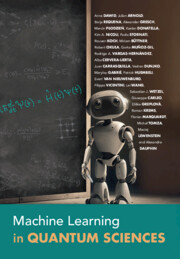Refine search
Actions for selected content:
3312 results in Quantum Physics, Quantum Information and Quantum Computation
2 - A Quantum Particle in One Dimension
-
- Book:
- Quantum Mechanics
- Published online:
- 27 June 2025
- Print publication:
- 19 June 2025, pp 26-71
-
- Chapter
- Export citation
4 - A Qubit
-
- Book:
- Quantum Mechanics
- Published online:
- 27 June 2025
- Print publication:
- 19 June 2025, pp 125-140
-
- Chapter
- Export citation
11 - Hamiltonians with Time Dependence
-
- Book:
- Quantum Mechanics
- Published online:
- 27 June 2025
- Print publication:
- 19 June 2025, pp 355-381
-
- Chapter
- Export citation
5 - The Harmonic Oscillator
-
- Book:
- Quantum Mechanics
- Published online:
- 27 June 2025
- Print publication:
- 19 June 2025, pp 141-163
-
- Chapter
- Export citation
6 - A Quantum Particle in Three Dimensions
-
- Book:
- Quantum Mechanics
- Published online:
- 27 June 2025
- Print publication:
- 19 June 2025, pp 164-205
-
- Chapter
- Export citation
References
-
- Book:
- Quantum Mechanics
- Published online:
- 27 June 2025
- Print publication:
- 19 June 2025, pp 677-682
-
- Chapter
- Export citation
12 - Atoms
-
- Book:
- Quantum Mechanics
- Published online:
- 27 June 2025
- Print publication:
- 19 June 2025, pp 382-427
-
- Chapter
- Export citation
Copyright page
-
- Book:
- Quantum Mechanics
- Published online:
- 27 June 2025
- Print publication:
- 19 June 2025, pp iv-iv
-
- Chapter
- Export citation
Further Reading
-
- Book:
- Quantum Mechanics
- Published online:
- 27 June 2025
- Print publication:
- 19 June 2025, pp 671-676
-
- Chapter
- Export citation
9 - Particles in a Magnetic Field
-
- Book:
- Quantum Mechanics
- Published online:
- 27 June 2025
- Print publication:
- 19 June 2025, pp 278-310
-
- Chapter
- Export citation
1 - The Wavefunction
-
- Book:
- Quantum Mechanics
- Published online:
- 27 June 2025
- Print publication:
- 19 June 2025, pp 8-25
-
- Chapter
- Export citation
10 - Approximation Methods
-
- Book:
- Quantum Mechanics
- Published online:
- 27 June 2025
- Print publication:
- 19 June 2025, pp 311-354
-
- Chapter
- Export citation
7 - Symmetries
-
- Book:
- Quantum Mechanics
- Published online:
- 27 June 2025
- Print publication:
- 19 June 2025, pp 206-264
-
- Chapter
- Export citation
3 - The Formalism of Quantum Mechanics
-
- Book:
- Quantum Mechanics
- Published online:
- 27 June 2025
- Print publication:
- 19 June 2025, pp 72-124
-
- Chapter
- Export citation
Dedication
-
- Book:
- Quantum Mechanics
- Published online:
- 27 June 2025
- Print publication:
- 19 June 2025, pp v-vi
-
- Chapter
- Export citation
Contents
-
- Book:
- Quantum Mechanics
- Published online:
- 27 June 2025
- Print publication:
- 19 June 2025, pp vii-xiv
-
- Chapter
- Export citation
8 - Identical Particles
-
- Book:
- Quantum Mechanics
- Published online:
- 27 June 2025
- Print publication:
- 19 June 2025, pp 265-277
-
- Chapter
- Export citation
16 - Quantum Foundations
-
- Book:
- Quantum Mechanics
- Published online:
- 27 June 2025
- Print publication:
- 19 June 2025, pp 562-619
-
- Chapter
- Export citation

Machine Learning in Quantum Sciences
-
- Published online:
- 13 June 2025
- Print publication:
- 12 June 2025
Note on the text
-
- Book:
- Machine Learning in Quantum Sciences
- Published online:
- 13 June 2025
- Print publication:
- 12 June 2025, pp xx-xx
-
- Chapter
- Export citation
